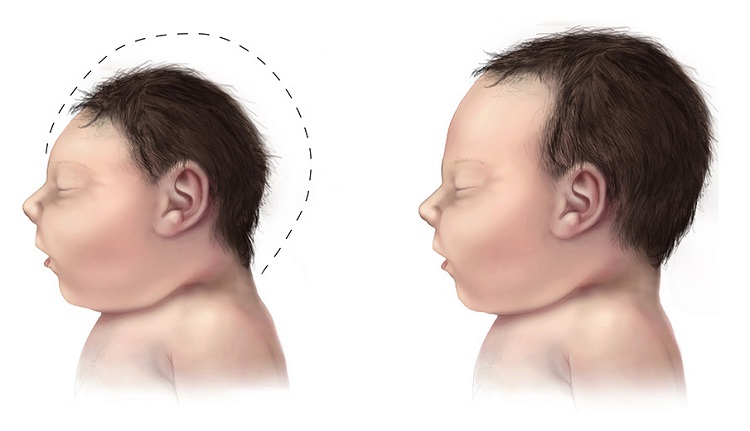Hyperemesis gravidarum, more commonly known as severe morning sickness, is the type of intractable vomiting that lasts well beyond morning and well after the first trimester. It affects up to 2% percent of all pregnant women and often leads to serious maternal and fetal health complications, including mortality. Although many theories abound, hormone changes and psychosocial stressors among them, the research is extremely limited and, more often than not, steeped in tried and not-so-true aphorisms of the blatantly obvious. Of course hormones play a role and of course stress is involved but neither are requisite to evoke the continuous vomiting experienced by some women.
As a result of our fealty to the obvious, we have no idea what causes the vomiting or how to treat it; leaving women to suffer and their physicians and midwives few tools to alleviate the vomiting. Nevertheless, there are clues from other disciplines and other diseases processes that if we piece them together correctly might point us towards a cause, and more importantly, new treatment options.
If you have followed my work here on Hormones Matter, you’ll know that I spend a lot of time understanding pharmaceutically and environmentally induced damage to the mitochondria. Over the years, I have come to realize that every illness involves the mitochondria in some manner or another. In some instances mitochondrial impairment precipitates illness. In others, it is a consequence of the illness and, in yet other cases, the disease processes involved are a gobbled mess with mitochondrial cascades initially meant to be protective promoting a sort of self-perpetuating damage that is difficult to unwind much less assign fundamental causation. No matter the origins of mitochondrial distress, however, it is my belief that if we look to the mitochondria first we can solve a great number of previously unsolvable disease processes, including hyperemesis.
Outside the Box with Hyperemesis Gravidarum
Not known for coloring within the lines, I often look for clues about disease processes outside the given discipline. So disregarding most of the hyperemesis research, I looked for other ways into this condition. Specifically, I wondered if mitochondrial disorders that cause vomiting independent of pregnancy, like Cyclic Vomiting Syndrome (covered here) or pregnancy complications that fell outside of the hyperemesis classification, but caused severe vomiting nonetheless, such as Acute Fatty Liver of Pregnancy (AFLP), would provide clues and treatment opportunities for severe morning sickness. Indeed, they did.
In both of these disease processes (and a few others), severe, ‘unexplained’ nausea and vomiting are present and, more importantly, share mitochondrial components in the form of deficient fatty acid oxidation. It appears that with Cyclic Vomiting Syndrome (CVS) and AFLP, a critical component of mitochondrial energy production is impaired within the liver (and likely elsewhere) that hinders the liver’s capacity to metabolize fatty acids and detoxify metabolic waste products effectively. When hepatic mitochondria are defunct, liver function is compromised leading to the nausea and vomiting. We get deficits in mitochondrial bioenergetics (made worse by the increased energy demands of pregnancy), but also, a buildup of toxins (energy starved mitochondria cannot clear waste products effectively), and an accumulation of unprocessed fatty acids, all leading to the body’s only mode of clearance, vomiting.
Mitochondrial Fatty Acid Metabolism
The mitochondria take nutrients from food, consume oxygen, and convert those nutrients into a fuel source (adenosine triphosphate ATP) that the cells use to function (learn more). There are three primary mitochondrial fuel pathways (and a whole bunch of secondary and tertiary pathways), one for carbohydrates, one for proteins, and the other for fats, disrupt one or more and all sorts of problems arise. Disrupt these pathways in the liver, the organ responsible not only for toxic waste removal but also for glycogen and fatty acid processing and storage, and the problems become exponentially worse. In the case of the severe morning sickness of pregnancy, I suspect that the mitochondrial beta oxidation pathway, the route for turning fatty acids into ATP, is disrupted.
How to Damage Mitochondria: Let Me Count the Ways
Mitochondrial function can be disturbed by a number mechanisms. Sometimes there are heritable genetic mutations, but not always. Heritable genetic mutations are called primary mitochondrial disorders and occur in up to 1 in every 200 individuals. Fortunately, not all mutations result in illness, but when they do, the results are often devastating.
More frequently, researchers are seeing what are called secondary, acquired, or functional mitochondrial damage evoked lifestyle variables. Epigenetic injuries, sometimes from generations past, have become increasingly common routes to disease. Epigenetic injuries do not induce mutations per se, but rather, aberrantly turn on or turn off gene activity that then influences mitochondrial function. Epigenetic activation or deactivation occurs relative to environmental influence, exposure to toxicants, stressors and/or other variables.
Among the least well recognized secondary mitochondrial injuries are those that are purely environmental; cumulative dietary and lifestyle exposures that damage multiple aspects of mitochondrial functioning. Many environmental and pharmaceutical chemicals evoke mitochondrial damage by leaching critical nutrients needed for mitochondrial energy production and other mitochondrial and cellular functions, but they also damage the structural or functional integrity of these organelles. The cumulative damage of everyday exposures when combined with genetic, epigenetic and/or poor dietary choices, render many individuals susceptible to mitochondrial illnesses. I suspect many of the idiopathic pregnancy complications, like hyperemesis, have their roots in mitochondrial dysfunction.
Although most of this paper, and indeed, most of the popular press focuses on mitochondrial bioenergetics, we must keep in mind that the mitochondria regulate a number of other important and endlessly reciprocal cellular functions, namely: steroidogenesis, immune signaling and cell death. Disturbances in mitochondrial bioenergetics, thus, would be expected impair hormone regulation, induce uncontrolled inflammation (chronic inflammatory and autoinflammatory diseases) and initiate tissue and organ injury. Individuals with mitochondrial issues would be expected to have a broad range of subtle and not-so-subtle health issues; many of which are endemic and epidemic in Western cultures.
Clues for Hepatic Mitochondrial Dysfunction in Hyperemesis Gravidarum
Backing up a bit, let’s connect some dots from the AFLP research. From the research on AFLP, we know that a mutation in the mitochondrial enzyme responsible for processing an important mitochondrial transporter evokes some, but not all of the cases of this disease process. Notably, in some women with hyperemesis, the fetus carries the mutation and evokes the vomiting, while mom is simply a heterozygous carrier.
The mutation (L-3-hydroxyacyl-CoA dehydrogenase deficiency – LCHAD) involves an enzyme (carnitine palmitoyltransferase I – CPT I) responsible for synthesizing the protein that acts as key transporter for fatty acids across the mitochondrial membrane. The protein involved is called carnitine.
When a fetus carries the CPT I mutation, the fetus’ inability to metabolize fatty acids and the associated bi-products are kicked back into maternal circulation effectively overriding the mom’s capacity to process these compounds. The increased load on the mom’s liver induces the vomiting, leading, in some cases, to the compensatory reaction of fat deposits within the liver cells – AFLP. Since AFLP is relatively rare, developing in only 7-10 per every 100,000 pregnancies, is not present in all hyperemesis cases (50% of women with severe vomiting show some liver damage), and the fetal mutation is even rarer, we can deduce that neither AFLP nor the mutations that impair fetal fatty acid metabolism account for the totality of hyperemesis cases or even the morning sickness of early pregnancy.
Nevertheless, this research provides several important clues about hyperemesis. First, given the right set of circumstances, e.g. pregnancy or another high intensity stressor, carriers of a particular mutation may become symptomatic. We often view heterozygous carriers as being asymptomatic or less symptomatic than their homozygous counterparts. This may not be true. We may be simply viewing the symptom status incorrectly. Secondly, mitochondrial fatty acid metabolism is likely impaired and in some manner related to carnitine. Thirdly, maternal hyperemesis may not be a primary mitochondrial disorder in the classical sense (those definitions are changing, however). Even though there are a number of possible genetic mutations involved with the carnitine pathway, most are either severe enough to be identified during infancy (save except CPT II, which may remain latent until adolescence or early adulthood) and/or present differently (with muscular weakness and cardiomyopathy), and therefore preclude them from our differential. For all intents and purposes, hyperemesis presents during pregnancy, mostly in women with no known fatty acid oxidation or carnitine-related mutations, suggesting non-genetic mechanisms at play. In other words, I think we’re looking for functional mitochondrial disturbances in fatty acid metabolism related to carnitine.
What is Carnitine?
Carnitine is an essential micronutrient derived from the amino acid lysine with the help of methionine (an essential amino acid derived from diet). It is highly expressed in liver, testes and kidney. Dietary carnitine from meats, dairy and other sources yield carnitine. (L-carnitine is biologically active isomer. The research nomenclature varies considerably. For consistency, the word carnitine will be used throughout except when speaking of supplementation, where L-carnitine is more appropriate.) Carnitine is then shuttled off to skeletal and cardiac muscle where fatty acids are used as a primary fuel source. Although it is believed that endogenous carnitine homeostasis is maintained to some extent despite dietary contributions, there are number of conditions that override the internal synthesis of carnitine. These include genetic mutations that limit carnitine synthesis, difficulties with nutrient absorption (leaky gut or bacterial imbalances), kidney dysfunction which limits carnitine re-absorption, pharmacological inhibition of carnitine transporters, and nutrient deficiencies that disrupt any of the many enzymes involved in carnitine biosynthesis or metabolism.
In addition to its direct role in fatty acid metabolism, carnitine is also involved in glucose metabolism (the other major source of mitochondrial ATP) via its potentiating role in the pyruvate dehydrogenase complex, its modulation of acyl-coenzyme A (CoA) and the storage of acylcarnitine. So when we disrupt carnitine availability, by whatever mechanism, not only is fatty acid metabolism derailed, but the other primary pathways for mitochondrial energy production are negatively impacted, as are the storage and clearance pathways.
Carnitine, Fertility and Pregnancy
We know very little about carnitine during pregnancy except that it generally declines. Below is a review the literature.
In women undergoing in vitro fertilization, higher maternal carnitine concentrations are associated markedly improved fertilization rates and overall better outcomes. Competent fatty acid oxidation is required for oocyte and embryonic development.
During pregnancy maternal carnitine concentrations diminish significantly. Indeed, at delivery, plasma carnitine concentrations have been reported 50% lower than in non-pregnant women. Researchers don’t know why carnitine decreases so much during pregnancy. There is some indication that carnitine concentrations are inversely related to iron status. Iron is needed for carnitine biosynthesis and so the increased demands for iron during pregnancy, if not met, may negatively impact carnitine synthesis. Since carnitine crosses the placental barrier, maternal carnitine deficiency would lead to fetal carnitine deficiency. The research, however, is all but nonexistent.
From animal research, we know that supplementing with L-carnitine, maintains carnitine concentrations across the pregnancy and improves a number of variables associated with reproductie function. Supplementation with L-carnitine also appears to offset liver damage and improve liver function in a mouse model of acetaminophen induced liver toxicity. Similar to the human IVF research mentioned above, L-carnitine supplementation improves oocyte development while increasing overall fatty acid oxidation capabilities.
Carnitine Deficiency with Nutrient Depletion
Population data for carnitine deficiency are unknown but nutrient deficiencies in general are postulated to be non-existent in the developed world, except with poverty. This assumption is erroneous and dangerous in the land of nutrient stripped processed foods. What little data exist for different nutrients, show that a significant portion of the Western population is deficient in one or more nutrients. Nutrient deficiencies impact enzyme function and the mitochondria’s ability to produce ATP and perform other critical functions. Carnitine synthesis alone requires five different enzymes, each with their own nutrient demands. This is in addition carnitine’s requirement for lysine and methionine. Given such demands, it is entirely conceivable, and in fact likely, that Western women come to pregnancy deficient, either marginally or grossly, in any one of the many nutrients involved in the carnitine pathway. Here are just a few.
Possible Nutritional Culprits in Functional Carnitine Defiency
Endogenous carnitine synthesis requires methionine. Methione concentrations in foods have steadily decreased (by as much as 60%) in parallel with the increase in glysophate (Roundup) used in conventional agricultural practices. Methionine synthesis also requires vitamin B12, a nutrient deficiency common with the Western diet and exacerbated by many medications.
One of the only accepted treatments said to reduce the nausea in hyper-emetic women is vitamin B6 supplementation. Vitamin B6 is involved in carnitine synthesis. It is also an important anti-inflammatory, especially in the central nervous system.
The other nutrients required to maintain active enzymes for carnitine synthesis include: iron, niacin (B3) and vitamin C.
Finally, with pregnancy in general, but especially, with pregnancies involving severe nausea and vomiting, the risk of nutritional deficits is exacerbated as the intake of nutrients diminishes. Not only would we expect carnitine depletion but deficits in many of the other vitamins and minerals required by the mitochondria to produce ATP either via fatty acid metabolism or via glucose metabolism. The vomiting itself depletes nutrient stores, and thus, becomes self-propagating; fewer nutrients > more vomiting, more vomiting > fewer nutrients.
Connecting the Dots: Potential Treatment Options for Hyperemesis Gravidarum
Thus far, the clues point to some sort of functional, epigenetic, or even an unrecognized, but latent, genetic derailment of fatty acid metabolism involving carnitine. The deficit in carnitine then precipites the severe morning sickness of pregnancy known as hyperemesis gravidarum. The nausea and vomiting worsen nutrient deficiencies and continue the cascade. If this is true, and I think it is, then the question becomes, can we support the carnitine system and mitochondrial function in general, to alleviate or completely eliminate the vomiting. I think we can.
I mentioned cyclic vomiting syndrome in the early sections of this post but haven’t spent any time on the topic. It is from the cyclic vomiting research that we find our treatment options. Specifically, Dr. Richard Boles has successfully treated pediatric patients who have cyclic vomiting syndrome with L-carnitine and Co-Enzyme Q10 (CoQ10), as have others. Indeed, we have personal experience with Dr. Boles’ work, as the daughter of one our writers had treatment refractory cyclic vomiting syndrome; that is, until the L-carnitine and coQ10 eliminated the constant vomiting. Cyclic vomiting syndrome is believed to be a mitochondrial disorder falling under a category of disorders called dysautonomias. And though a specific mitochondrial genotype has not been linked to CVS, Dr. Boles’ clinical data shows a clear association with mitochondrial fatty acid oxidation (L-carnitine supplementation) and the electron transport function (coQ10 supplementation).
Other Bits and Pieces
Fatty acid and carbohydrate metabolism within the mitochondria are closely tied to each other, with multiple interleaving levels of reciprocity. Both pathways demand nutrients to power their enzymes. A nutrient that is particularly high on food chain for mitochondrial function, is vitamin B1 or thiamine. We’ve written about thiamine deficiency repeatedly, as it seems to be leached from the mitochondria by a number of medications and vaccines and is implicated in a wide variety of adverse medication reactions. As a core nutrient in the pyruvate dehydrogenase enzymes, thiamine is critical for ATP production. Thiamine is also critical for fatty acid metabolism. A borderline thiamine deficiency would impair fatty acid metabolism and is linked to hyperemesis related liver damage and Wernicke’s Encephalopathy. Thiamine deficiency also impairs brainstem control of vomiting, thereby exacerbating the already difficult-to-control pregnancy hyperemesis. Thiamine supplementation should also be considered for hyperemesis gravidarum. Our own Dr. Lonsdale tells us that he has used thiamine in clinical practice to reduce cyclic vomiting in pediatric patients. The research on hyperemesis gravidarum, however, is extremely limited, focusing solely on the use of thiamine to curb the effects of hyperemesis-induced Werknicke’s syndrome.
Final Thoughts
Although there is little direct evidence linking a functional carnitine deficiency in pregnancy to hyperemesis gravidarum, there are a enough indirect data to suggest this may be a mechanism worth investigating. If this work bears fruit, L-carnitine, CoQ10, thiamine, vitamin B6 and likely other nutrients may be all that are needed to alleviate the nausea and vomiting across pregnancy.
Please note, I am not a medical doctor and this should not be construed as medical advice. Please speak to your healthcare practitioner before beginning any treatment protocol.
If there are any physicians or midwives who have used L-carnitine in patients with hyperemesis, please comment below.
We Need Your Help
More people than ever are reading Hormones Matter, a testament to the need for independent voices in health and medicine. We are not funded and accept limited advertising. Unlike many health sites, we don’t force you to purchase a subscription. We believe health information should be open to all. If you read Hormones Matter, like it, please help support it. Contribute now.
Yes, I would like to support Hormones Matter.
This post was published originally on Hormones Matter on July 22, 2015.













